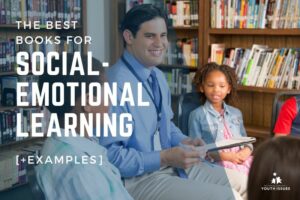
Menu

Six years ago, I started an experiment where I spoke with each student during the first week of school. I learned that this 45-second investment in each student, coupled with proactive, clear expectations, created positive relationships with students in an inclusive, safe, care-based classroom.
The beginning of the school year can be stressful! There’s so much pressure around starting the year off “right.”
Every August since 2009, teacher dreams have infiltrated my mind with impossible classroom setups and me yelling so that the kids around the corner and down the stairs behind the column can hear me. Meanwhile, I can’t find the stack of papers to hand out that I never copied. The fear of this happening in real life has caused me to be overprepared and utilize the following strategies to begin transforming classroom culture during the first week of school.
On the first day, I greet students at the door with a smile, letting them know there is a seating chart and a survey for them to work on. This eases anxiety about where to sit and gives them something to do right away. The survey consists of open-ended questions to get to know them better and includes a mini-contract about open communication and my care for their success and well-being as a whole person. I hand out pencils as needed.
While students fill out a get-to-know-you survey, music is playing to alleviate awkwardness. I tell students that I will walk around and quietly introduce myself to each of them. I ask that they introduce themselves to me, clearly saying their first and last names. This allows me to make eye contact and lets them say their name (while I make notes on the seating chart), so that I don’t mispronounce it in front of the whole class and risk embarrassing the student.
Next, I give a brief presentation about myself with pictures, so that students can see that I, too, am a real human being with passions outside of school. I share that I have been skydiving (never again), ran a marathon (over a decade ago), and enjoy Ultimate Frisbee. I show a picture of my young kids in the classroom helping me set up (as long as setting up means dumping out the bin of markers).
I include short, simple expectations around my hope for the class (a safe learning environment where we are all kind and work hard while taking risks). We end the class with name games and getting to know classmates.
During the first week of school, I assign something fun and simple. I sit in the back of the classroom (while music plays and students chat) and call each student over. I scan their surveys from the first day and highlight something I have in common with them or what I’m interested in knowing more about.
I will say things like, “Oh, I really enjoy reading, too!“ or “Yeah, I had older siblings growing up as well,” or “What’s an ollie trick?” The most important thing is to make eye contact and to let them know that I’m glad to have them in class and that I care for and am here for them. I also acknowledge if they have an educational plan and how I will support them in this.
Why do these conversations transform classroom culture? Students feel valued, respected, and seen by you, which means they are less likely to act out. They see you as a person and will be more likely to approach you with questions or issues, since they’ve already talked to you one-to-one. Students will feel safer and more willing to take educational risks. It allows for a clean slate to build a positive relationship with you, regardless of whatever reputation they came in with.
Of course, these conversations need to accompany respect for all students, coupled with clear expectations, which you consistently handle when they are not met. Being proactive (strategically placing students, scaffolding/differentiating assignments, quietly checking in with students who need extra support during the first few minutes of work time, explicit directions and grading rubric) will prevent potential disruptions.
To continue building community, it’s important that students learn everyone’s name in the classroom. I use random groups for everything, and the protocol is to share names and connect first. This alleviates social difficulties around picking groups, allows students to step up into different roles, and ideally enables them to start unlikely friendships. We have fun routines built in, like engaging questions before group work, two truths and a lie once a week, and icebreaker games throughout the year.
Things will still come up throughout the year! Unexpected behaviors are communication that a student’s needs are not being met. In these situations, I address issues in the moment (ideally away from classmates) with a conversation where I first try to connect with them about what they are feeling or needing. I remind them that I care for them as a person and know that their behavior choice is separate from who they inherently are.
Since we had a conversation the first week of school, it’s easier to talk and come up with a plan to get the student what they need in order to feel successful and have the classroom be a calm, respectful, and safe environment.
Even if you are reading this midyear, it’s never too late to implement individual conversations with students and move toward positive change! I hope these small strategies can help make a big difference in your classroom culture.
Written by Lindsay Kervan.
Sign up for our Newsletter
The semi-monthly eNewsletter features:
Please note that we use cookies necessary for the functioning of our website and to optimize performance. To learn more about our cookies and how we use them, please read our Privacy Policy.